-
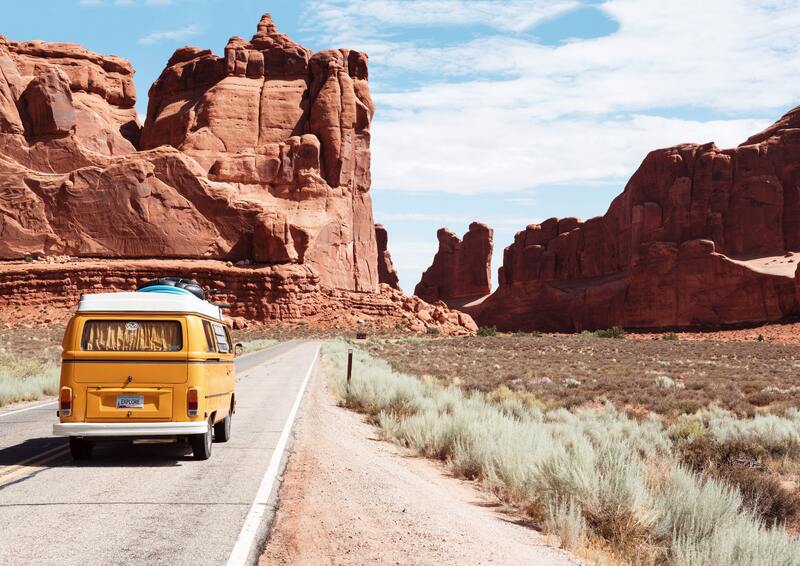
2023-02
Worldwide, nations implemented social distancing and disease mitigation strategies in the Spring of 2020. These policies varied widely, but many places experienced restrictions on personal movement and travel.
For your submission, respond to the following prompt:
When travel restrictions were lifted, did you take a trip? If so, where did you go and why? What are your memories of this trip? Were there any continuing COVID-19 restrictions in place?
If you did not travel and have still not traveled, answer the following question: If you could travel anywhere, where would you go and why? What destinations would you be sure to see? How would you document your trip (journal, social media, etc.)?
How and What to Submit:
For this assignment, you'll submit one item that captures a travel memory that relates to the COVID-19 pandemic. You'll submit your item to the COVID-19 Archive Links to an external site.on the "Share your Story Page." Include the following metadata (information):
The title
The description (this is the most important part.
Tags: at a minimum (Arizona State University, HST 643, and History of Tourism). Feel free to add your own additional tags.
Type: Audio recording, photograph, video, text story, recipe, etc.
Date (When did this story happen)
Contributor (your name)
Location (where did/does this memory take place).
What to submit:
Submit your story to the archive
Submit the title of your story on Canvas and the date you submitted it. This will help me find it in the archive.
-
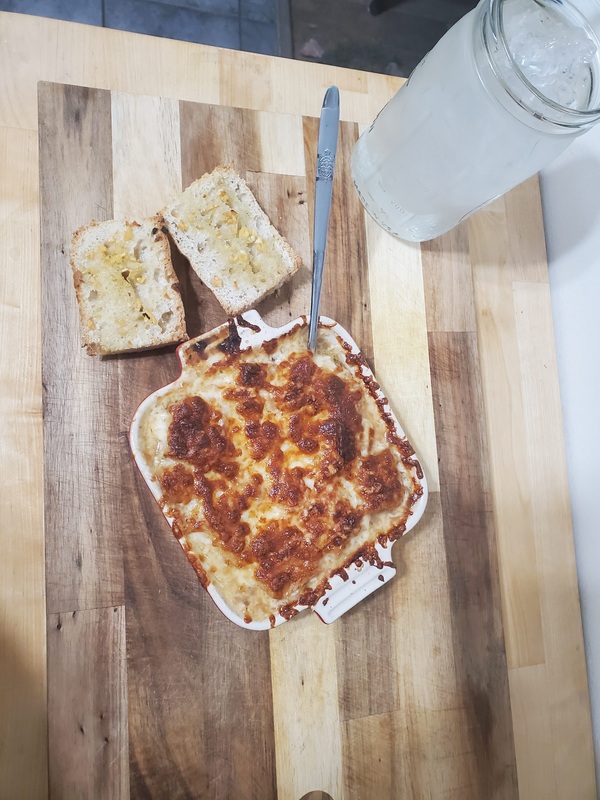
2020-08-08
I have loved to cook for as long as I can remember, but I had a few rough years and stopped cooking. With the onset of stay-at-home orders for the COVID-19 Pandemic, I went from 60-hour work weeks between my two jobs to nothing. My mind and hands were itching to do something, anything. As many of the grocery stores started to have supply shortages and I now had a much more limited budget; I had to get creative. So, I began to cook. I started slowly with fancy coffee drinks and eggs and moved to bread and pasta. Nationally people were baking bread so I thought well I’ve got the time I might as well try. What started as something I had learned to dread suddenly became my day’s highlight. I was cooking again! The dance of moving through my small kitchen. The clank of pots and pans and knives and wooden spoons in metal bowls playing in time to Otis Redding. The joy of tasting a recipe and nailing both the flavors and the serving size (many recipes serve 4-6, I live alone). It was truly a full-body experience. I soon realized that I hadn’t repeated any meals in about two weeks and decided to challenge myself to go as long as possible without repeating a recipe, if a meal required a repeat that portion simply didn’t count in my tally. I ended up making over 225 different recipes.
-
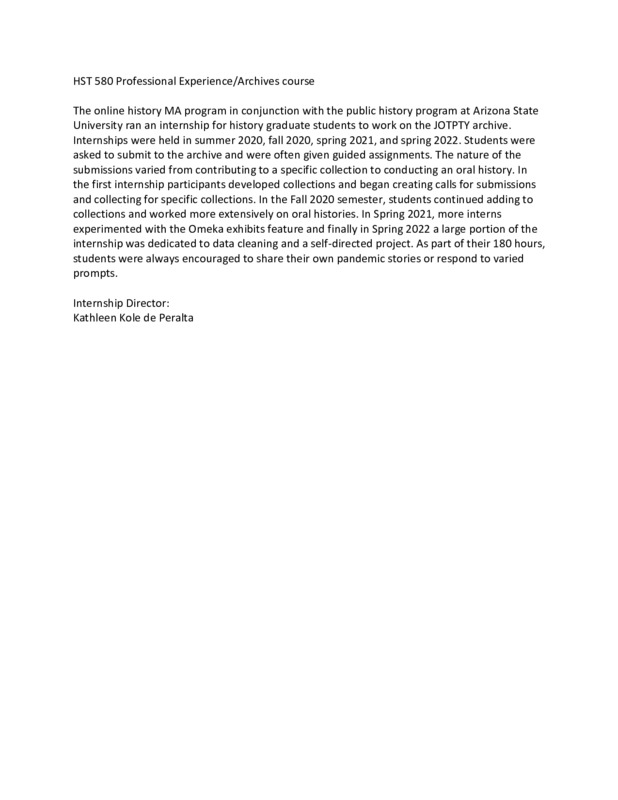
2022-08-02
The online history MA program in conjunction with the public history program at Arizona State University ran an internship for history graduate students to work on the JOTPTY archive. Internships were held in summer 2020, fall 2020, spring 2021, and spring 2022. Students were asked to submit to the archive and were often given guided assignments. The nature of the submissions varied from contributing to a specific collection to conducting an oral history. In the first internship participants developed collections and began creating calls for submissions and collecting for specific collections. In the Fall 2020 semester, students continued adding to collections and worked more extensively on oral histories. In Spring 2021, more interns experimented with the Omeka exhibits feature and finally in Spring 2022 a large portion of the internship was dedicated to data cleaning and a self-directed project. As part of their 180 hours, students were always encouraged to share their own pandemic stories or respond to varied prompts.
Internship Director:
Kathleen Kole de Peralta
-

2022-04-06
This is an Instagram post by carlamaeperaltasalmoringfkfhdk. This picture shows a kid that just got their second dose of the Pfizer vaccine. The date says that the shot happened on April 6, 2022.
-

2022-04-05
This is an Instagram post by namastou, and is partly in French. The comic posted in addition to the caption is by Ben Garrison, a political comic artist based in the United States. The comic shows how "truth" is being injected into "medical tyranny", and with that, the truth is that the masks are akin to making you slaves to the government, the vaccines cause gene alteration, and that PCR tests can come out as a false positive.
-
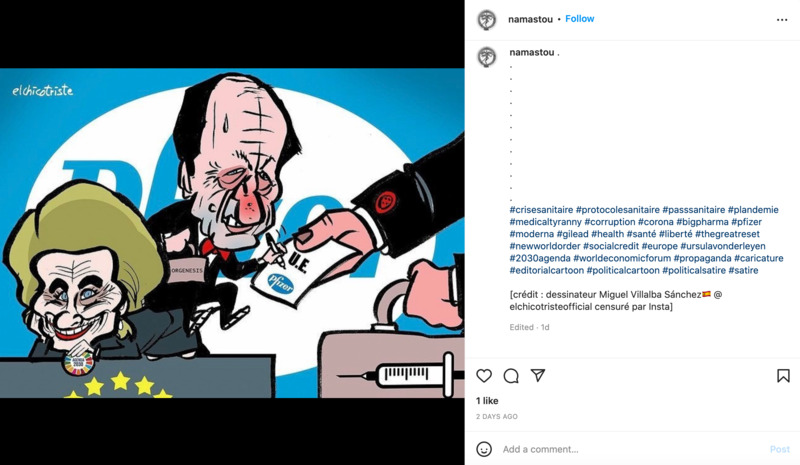
2022-04-05
This is an Instagram post by namastou. This post is partly in French. The picture depicted are people part of the European Union signing a deal with Pfizer, one of the vaccine producers. The 2030 Agenda that is referenced is about the year 2030 being the year all the problems COVID has caused will be solved. An article is linked to this post in order to give more context to the 2030 Agenda and what it means for this comic. The conspiracy theories surrounding the 2030 Agenda also have to do with the New World Order, which has been a long-standing conspiracy theory even before the pandemic happened.
-
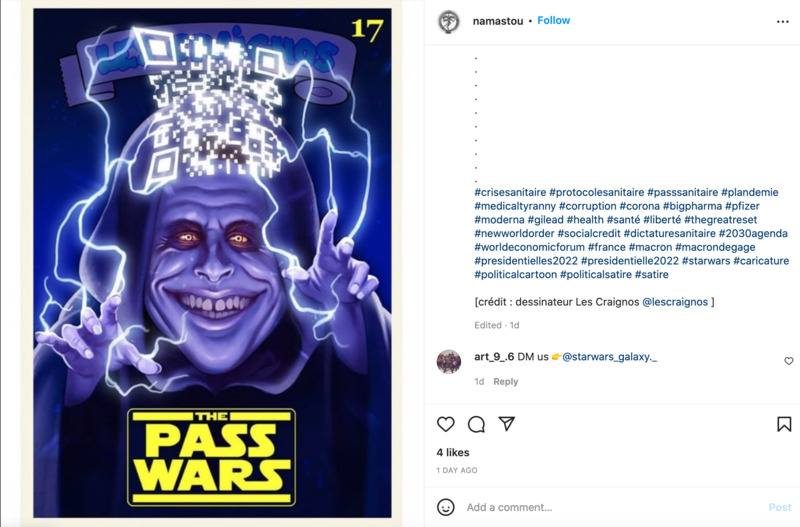
2022-04-06
This is an Instagram post by namastou. This post is partly in French, and it is a satire on Star Wars. The post references President Emanuel Macron, the current French president in the tags. It also uses the tag #plandemie, which is a French way of saying "plandemic", which is the belief that this pandemic was planned out by the rich in order to get richer and control their populace. They also say #liberté, or "liberty", possibly referring to their side being the side of freedom. #thegreatreset is another tag that is about the pandemic triggering a "great reset" where the rich have almost near control of the population through things like vaccine passports, which would limit freedom of movement if some refused to get the vaccine, thus creating discrimination between the vaccinated and unvaccinated.
-
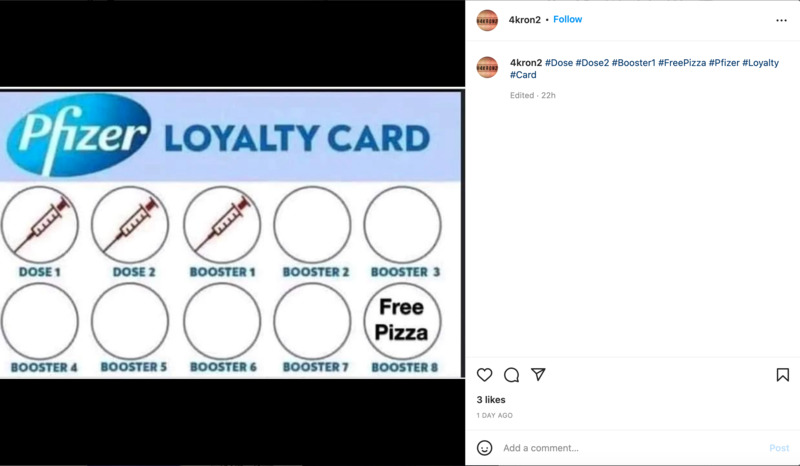
2022-04-06
This is an Instagram post by 4kron2. This user posted few tags, but the picture does give a lot of information. There has been a controversy on if booster shots are even needed, with some believing that this is a ploy by Big Pharma to get more money from the pandemic. This picture is a parody of loyalty cards some places have where if you buy a certain product or service enough times, you will get a reward.
-
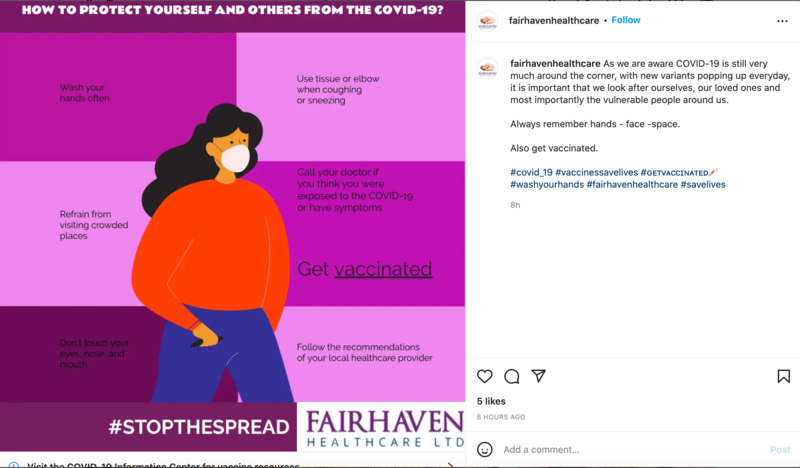
2022-04-07
This is an infographic on Instagram posted by fairhavenhealthcare. This infographic advises people to: use tissues when sneezing or coughing; wash hands often; refrain from crowded places; not to touch hands, mouth, or eyes; follow recommendations from healthcare providers; and get vaccinated.
-
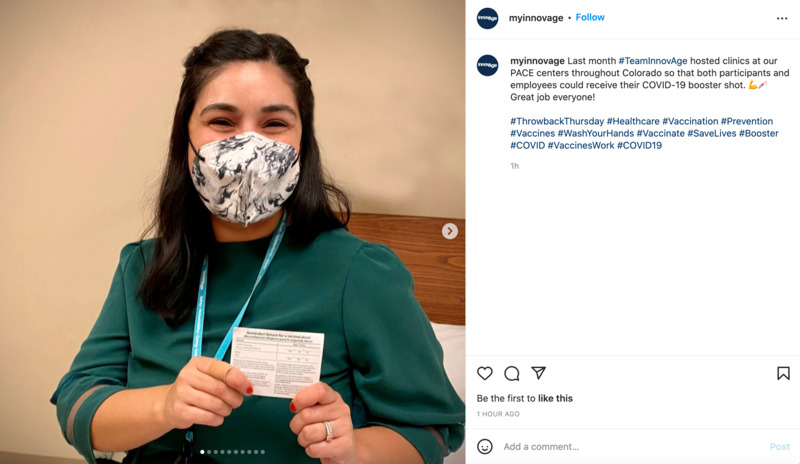
2022-04-07
This is an Instagram post from myinnovage. This is a team that worked on getting people vaccinated. Here, one of the pictures that was chosen was of a woman holding a blank vaccine card and wearing a mask. This team is in Colorado and is encouraging people to get their booster shots.
-

2022-03-07
This is an Instagram post from brotherkamil. This user is posting their skepticism surrounding the vaccine, believing that it will cause ill health effects. By abstaining from the vaccine, the user says that they are 100% safe from averse reactions.
-
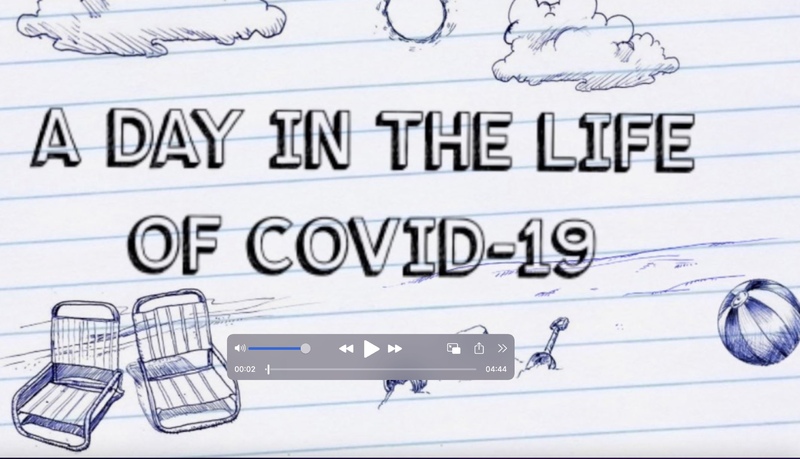
2022-03-16
Spend a day with me as you see me (Ashley Hampton) navigate through a normal day in present COVID-19 in Anderson, South Carolina. I vlog about my workplace, shopping centers, and businesses in Anderson to give perspective of how COVID-19 has changed the way these institutions function on a day-to-day basis. Despite statewide coverage, not much is documented about South Carolina and COVID-19 in this archive, let alone, residential experiences. The objective of this video is added to the South Carolina COVID archive as well as highlight how personal experiences with COVID-19 may vary depending on which region you live in and community.
-
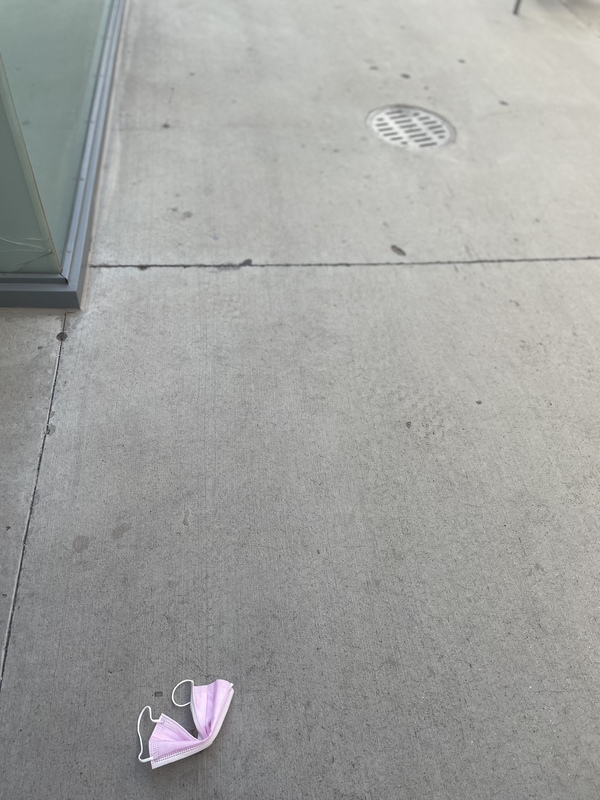
2022-02-08
A pink disposable mask on ASU’s campus near Coor.
-
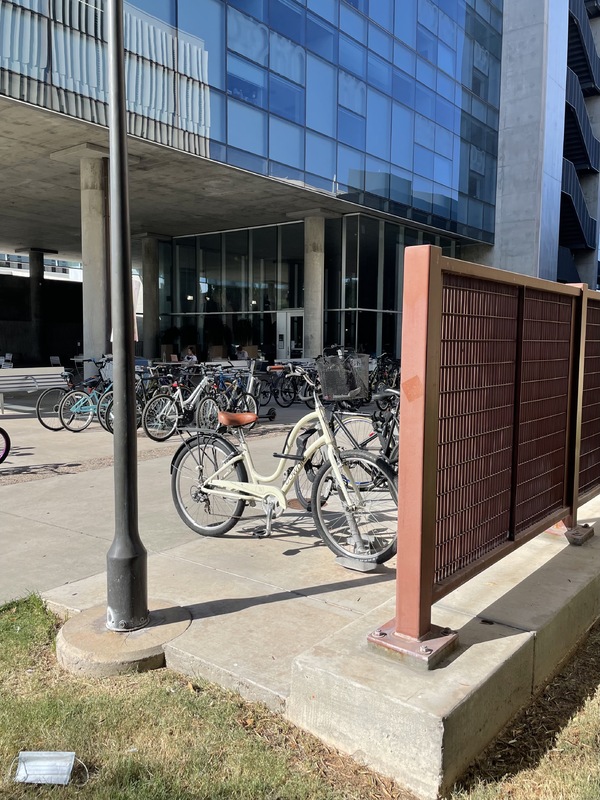
2021-09-22
A disposable mask was discarded/lost by the bike rack near the COOR building on campus.
-
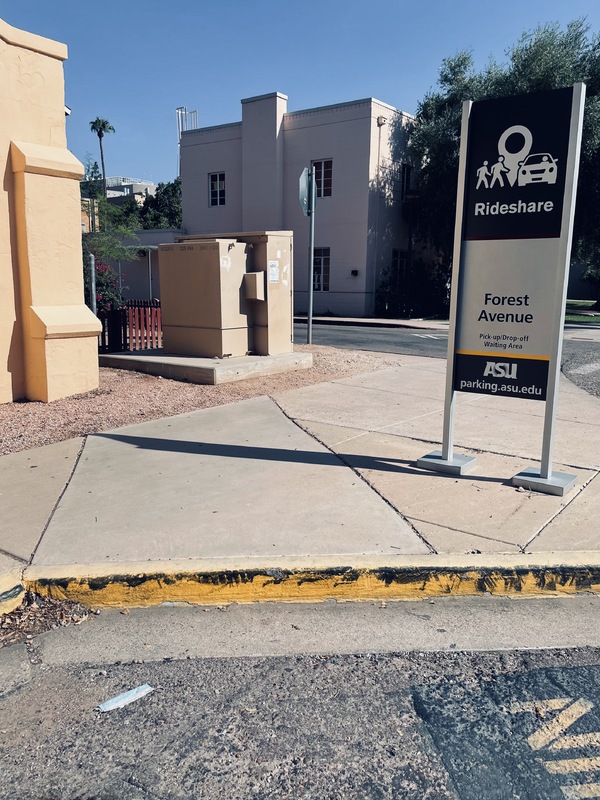
2021-09-03
Mask trash near the pick up-drop off at Forest Ave on ASU's campus.
-
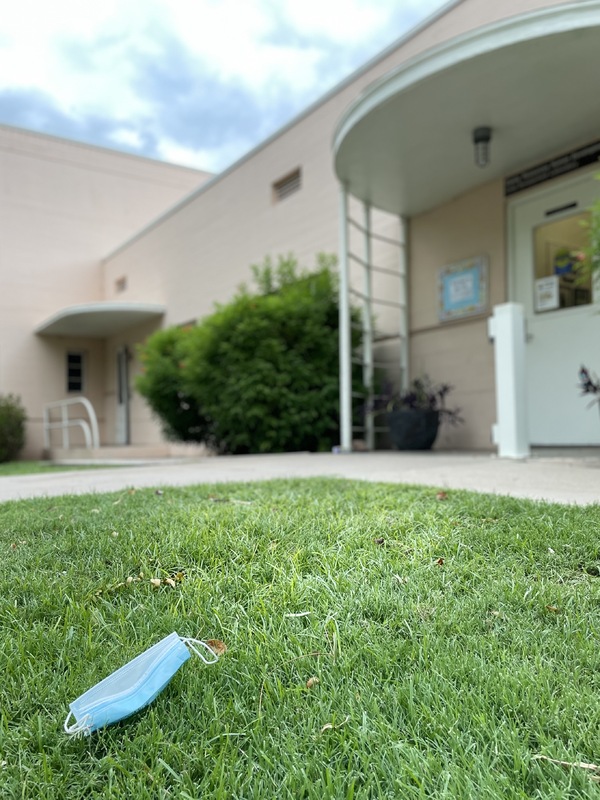
2021-08-21
Wednesday, August 18 was the eve of the first day of classes at Arizona State University. It was also the first week that the Child Development Lab (CDL) was open for daycare on campus. I picked my son up around 5:00 PM and took this picture of mask trash, likely unintentionally dropped by one of the parents outside the center.
This image is part of the mask trash series.
-

2021-08-08
The file that I have included is a description of how My wife and I were essentially forced to resort mostly on canned and frozen foods for our meals rather than using fresh ingredients.
-
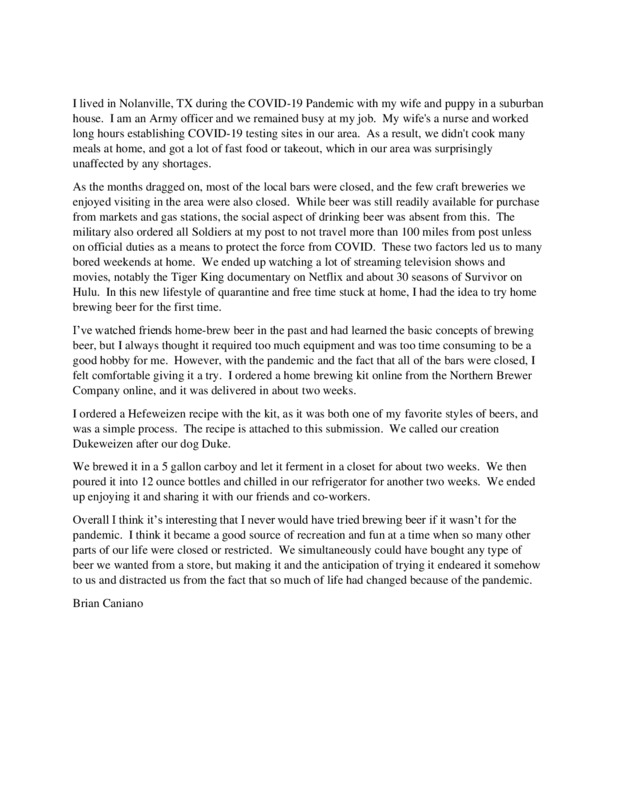
2021
I think my story in the attached document details how someone coped with the monotony of restricted activities from COVID-19, as well as the shutdown of social drinking.
-
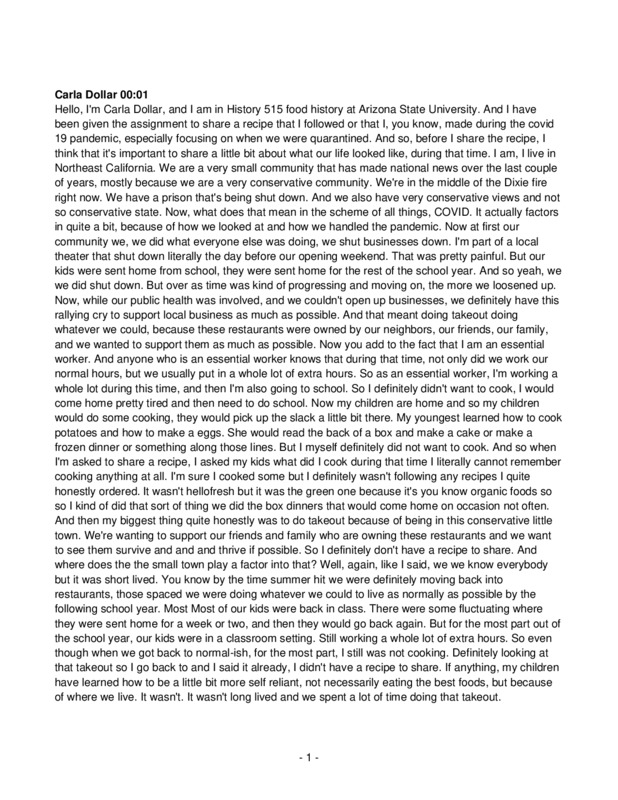
2020-03
I was given the assignment to share a recipe I made during quarantine that started March 2020. However, the reality was that as an essential worker, I had no time to cook. And in my tiny, conservative town, we rallied together to support local business. We ordered more take-out foods during that time, to support our friends and family who owned restaurants, but also, just didn't have time to cook.
-
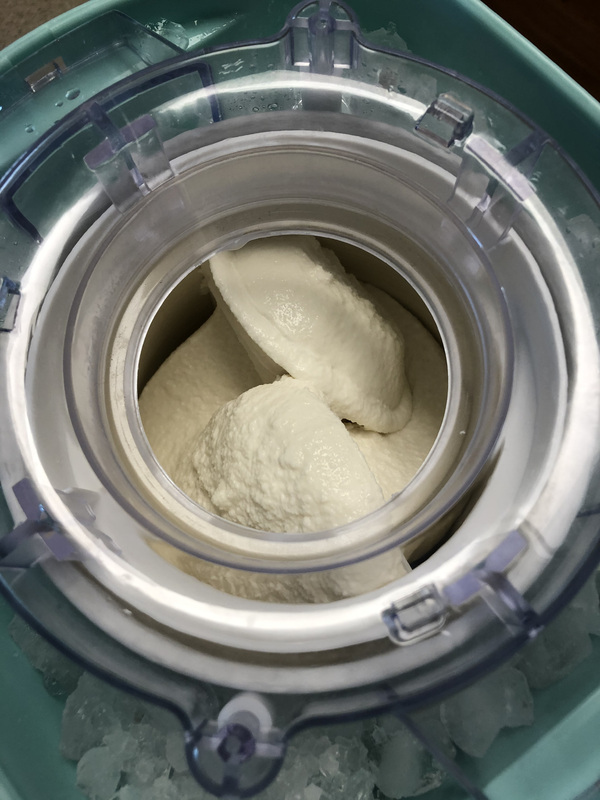
2020-04-14
I had just quit my job on February 28, 2020 since my military spouse and I were about to PCS (Permanent Change of Station) from Camp Lejeune, North Carolina, to New Orleans, Louisiana in late March. Mid-March the DOD issued a Stop Movement order for all troops so we ended up not moving until it was lifted on July 1. During the wait, we were in limbo not knowing what would happen with our moving situation, but fortunately we still had our house and stuff. My spouse picked up Covid on our house-hunting trip to New Orleans the first week of March before the Stop Movement was issued, but was never diagnosed since there were not enough tests to go around in North Carolina. For about two months we stayed home together, enjoyed each other's company, and made the best of it. I spent a lot more time in the kitchen than was previously normal, and loved every minute of it. Two years previously, my spouse gave me an ice cream maker for Christmas, but I never took it out of the box and it ended up in one of my difficult-to-reach upper cabinets. When I was organizing my pantry and kitchen cabinets one day to prepare for the time we would actually get to pack up and move, I spied it and thought I would finally give it a try. I have wonderful childhood memories of sitting around with my family and grandparents outdoors while the homemade ice cream my mom and grandmother made, churned in the electric ice cream maker on a hot summers day. I called my mom for her recipe and found a similar one online to reference (published by the Taste of Home test kitchen). The military commissary was out of a lot of groceries, so I made an online order at Sams since they had still had milk and heavy cream, and picked it up. I already had plenty of sugar and vanilla in my pantry. Before Covid, I rarely had time (because of work and school) to make desserts, so this dish was a real treat, a simple recipe, and was super fun to make. The taste of homemade ice cream was so lovely and smooth, with texture velvety, eating it right from the churn. It brought back all the wonderful memories eating homemade ice cream with my family as a childhood, to comfort me during a time I could not travel to see them. Food memories like this can transport one to a time when the world was full of closeness with one's family, when forced to separate due to a world-wide pandemic.
-
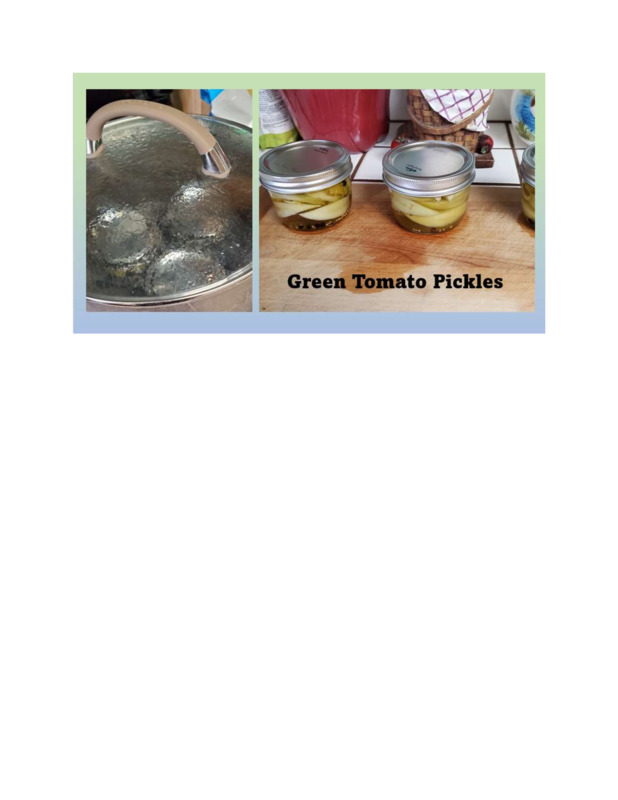
2021-08-08
Due to school closures because of COVID-19 in the spring of 2020, I finally had time to start a vegetable garden. This was something that I had wanted to do for years, but by the time I was out of school in June and had the time, it was too late in the season to begin. As a side note, the fact that school buildings were closed in no way means we teachers were not working hard to try to continue the education process for our students. The pandemic did change how we taught, though, giving me more time to finally begin my vegetable garden. This story is specifically about my tomato plants and the green tomato pickles I made from them.
I originally began my tomato plants from seeds on my kitchen windowsill in April. In mid-May, when they were about 8 inches tall, I transplanted them to a raised garden bed. This was my first experience growing a garden, so I overdid it with the number of vegetables I attempted to grow in my 4’ x 4’ space. Besides the tomatoes, I planted green beans, carrots, onions, beets, squash, zucchini, and cucumbers. The tomatoes and squash took over and that was all I got.
For some unknown reason, the first set of blossoms on the tomato plants didn’t produce any fruit. Late in the summer, I finally started to see some fruit, and it was early September before I was able to harvest any. At that point, though, they exploded with fruit. I live in the high desert north of Los Angeles and our weather is not quite as mild as the rest of LA County. We go our first freeze in mid-October. At that point I harvested about 5 lbs. of green tomatoes. A friend of mine had the same issue and decided to make green tomato salsa. I decided to make green tomato pickles.
I used a combination of recipes. I have a Little House on the Prairie Cookbook that I experiment with from time to time, but I modified some of the spices that recipe called for because I wanted dill pickles. So, I played around with it until I had what I wanted. They were excellent!
Then I did one more thing that I had never done before. I experimented with hot water bath canning so that I could preserve them longer. I ended up with eight jars of green tomato dill pickles, some of which made their way into Christmas gift baskets for friends and family. All of this was because I had more time on my hands due to COVID-19 and California’s Stay at Home order.
-
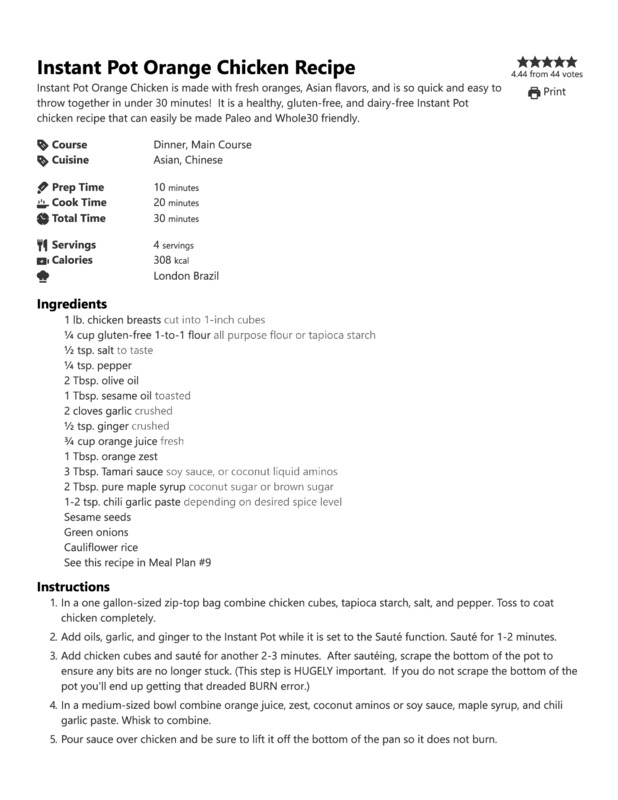
2020-04-09
Pre-Pandemic, my small family of three went shopping altogether at our local Frys Grocery every Sunday. As the type of person that lives inside their head and has difficulty multi-tasking when distracted, this was usually an overwhelming experience. It involved avoiding people parked sideways in aisles, answering questions from my wife and daughter (somehow usually at the same time), and being interrupted by loud intercoms. To me it was sensorial overload every week of my hearing and vision to the point where I wanted to leave.
When the pandemic really started up in April of 2020 my wife and I decided that my daughter should stay home and we would take turns shopping every week individually to decrease the chances of affecting the employees, the other customers, and ourselves. Along with this was my increased effort to come up with meals and recipes on my "turn." The recipe attached, gluten-free orange chicken from https://www.evolvingtable.com, reminds me of this interesting evolution in shopping that still takes place, as it is my turn to shop today. While my wife looks upon the idea of shopping individually as a loss and misses it...I am able to shop without being overwhelmed. Between less customers in the store (due to ordering online and pick up), the store progressing to using handheld radios, and being by myself, I can really focus and no longer am stressed and overwhelmed to the point where I just want to leave. Every time I make this recipe and taste the delicious orange flavor and smell that hot sesame oil that I had never used before the pandemic, it reminds me of how a stressful pandemic has strangely (and selfishly) made one recurring weekday of my life less stressful.
-
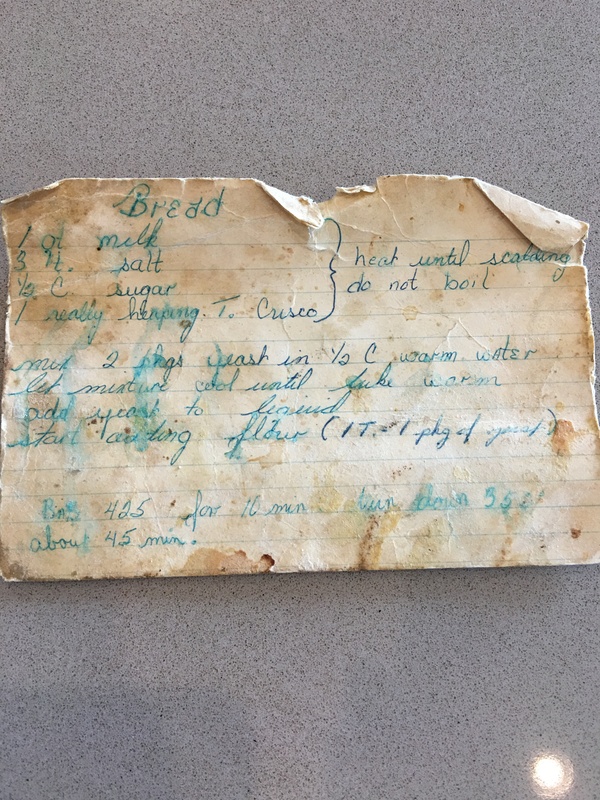
2020-03
Back in December of 2019, my wife and I were visiting my parents and grandparents in Mesa, Arizona. It was Christmas time, so we were enjoying a bit of leisure time that we typically didn't have. I had just graduated from Brigham Young University-Idaho with a degree in History Education, and my wife just finished a rigorous semester in her study of English at the same school. We were ready for a break.
Before meeting up with the family, my grandmother brought up the idea to teach my wife and I how to make homemade bread. It was her grandmothers recipe, and I loved it, as she would occasionally make the dough to make scones or kraut biscuits. This particular recipe made a lot of dough and needed to rise three times. Because of this, making bread was an all day event.
Just a few short months after learning to make bread in my grandmother's kitchen, COVID-19 shut down the world. We were living in Rexburg, Idaho at the time-a small town of around 28,000 people located in south-east Idaho. Given that we were in a rural location, we didn't feel the immediate effects of the virus like Seattle, New York City, and Los Angeles. However, around early March, schools shut down and we were told to stay indoors whenever possible.
Given that I was a teacher, I was suddenly learning how to run applications like Google Classroom to teach from home. The school district wasn't sure how long I would be working from home for. Initially, they only wanted to close for two weeks to deep clean the school. However, this ended up lasting through the end of the school year.
My wife was now also at home. Her studies switched from in-person courses to online courses. Professors who had spent their life in the classroom were suddenly figuring out how to teach via a new medium. It was challenging for all, but everyone seemed to be more patient with each other.
Given that my wife and I were home, and given that we had more time, we decided that we would make the bread recipe that my grandmother had taught us over Christmas break. Everyone was encouraged to only shop when absolutely necessary, so we added the flour and yeast to our shopping list. However, when we went shopping only a few days later, the baking isle had been decimated. The only types of flour that were left were expensive bags of specialty flour that came in much smaller portions. Yeast was nowhere to be found. Even things like baking soda were gone.
When I think back to the early days of the pandemic, I think of panic. While my wife and I were able to remain calm, many people worried they would not be able to find basic necessities. Grocery stores ran short on many items-toilet paper, canned food, flour, sugar, paper towels, cleaning supplies, amongst other things. Many things that were taken for granted were now an uncertainty. So while we did have more time on our hands, baking bread wasn't an option.
-
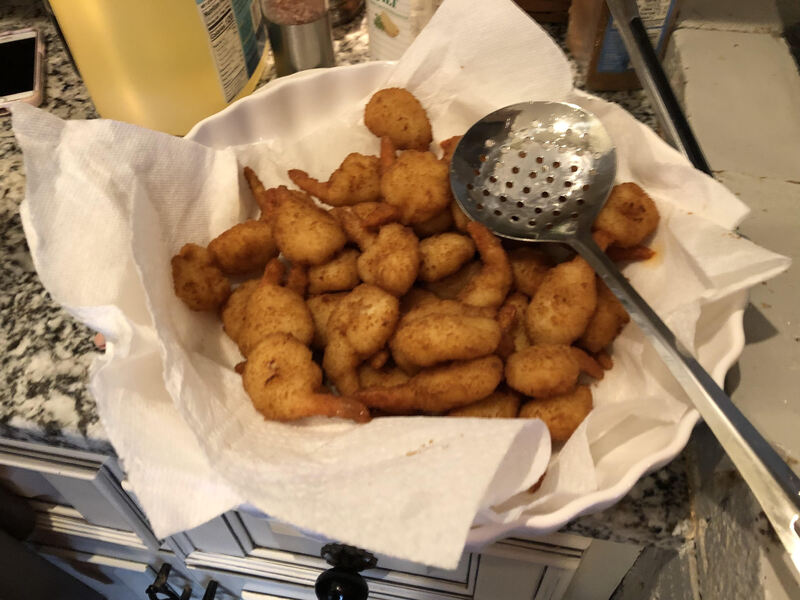
2020-03-14
The world changed as we Alabamians knew it on Friday, March 13th, 2020, as that was the last day that our school systems remained physically open before our governor mandated forced early system closures ahead of the approaching COVID pandemic. As a high school teacher, I uneasily said goodbye to my students and promised to see them on ZOOM the following Monday. When I arrived home, I found that my wife had contacted each of her family members to invite them to a seafood feast planned in our home for the next day, Saturday the 14th. We had recently purchased a tremendous variety and quantity of seafood for a planned early summer river gathering, including shrimp, crawfish, and fish; however, the pandemic was likely not going to allow for such a future gathering, and we knew of no way in which we could consume so much seafood ourselves, and were equally incognizant when we might gather as a family again, so this was essentially planned as a “McRight family last supper” (pardon the blasphemy, but that’s how we coined it). We had prepared each of the dishes before, save for Tamsie’s new experiment, her crawfish cheesecake. We had enjoyed crawfish and shrimp cheesecake at a wonderful restaurant, Roux 66, while traveling through Natchez, Mississippi several months previous; that culinary experience informed our desire to recreate the recipe at home! Thus, our sensory memory of better times and a delicious meal beckoned us to return to that sensory experience and give the recipe a try.
We researched online recipes to combine basic ingredients, including shrimp, crawfish, cream cheese, onions, eggs, and bell peppers, with two cheeses, minced garlic, Creole seasoning, salt and pepper, heavy cream, and a shrimp boil mix. The cheesecake was delicious, and the combination of garlic, crawfish, and shrimp contrasted with the sweet richness of the cream and eggs to make for a delightful dish. To this day, the smell of shrimp makes me think of those early days of the pandemic because our kitchen was filled with the aroma of that decadent crawfish cheesecake, shrimp scampi, a shrimp boil, fried fish, boiled shrimp, and fried shrimp. We hosted approximately twenty-five family members, we laughed, we talked about the future, and we expressed concern over what the coming days might bring. Afterward, we dismissed pandemic talk to release our concerns for the shank of the evening, as we were living for the moment and celebrating our being together.
I remember thinking but it might be a long time before we could get fresh seafood again, because we did not know if the opportunity to find fresh seafood would avail itself again in the near future, nor did we know if grocery stores would remain open. That was a time of complete uncertainty. I will likely never again enjoy a shrimp meal without thinking about March 14th, 2020, as the world in which we had lived mere days before somehow now seemed different, foreign, and unsettling.
-
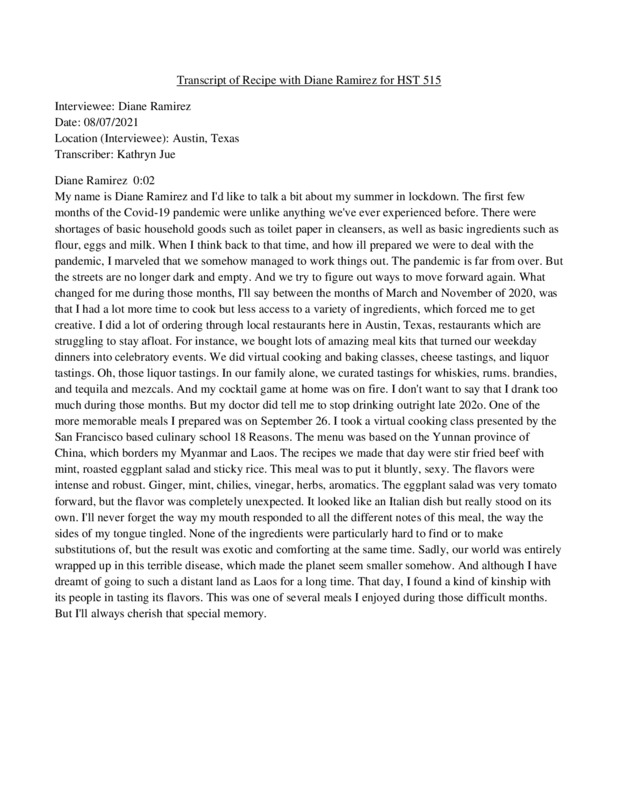
2021-08-07
How one Hispanic female dealt with the cooking challenges that took place in the early months of the pandemic. In particular, one meal she prepared on September 26, 2020.
-

2021-03-21
If you had asked me if I was a baker prior to the year 2020, I would have unequivocally said no. A cook? Yes. But a baker? Absolutely not.
But that was before the global Covid-19 pandemic. I worked in the cruise industry prior to the pandemic and I travelled a lot for my job. I was not home enough to really jump into and try to master baking. Following mandatory quarantine in March 2020, I suddenly had extra time on my hands. Further, I was laid-off from my job in early June and ended-up with even more time on my hands. Like so many around the world during quarantine, I took up baking. But unlike the many who tried sourdough, I started with making standard wheat breads and then went straight to enriched breads like babkas or challahs.
The photos I am attaching here show my progression as a baker. My first babka was fine and tasted great, but as you can see, I have improved in technique and in flavor over time. My favorite babka recipe comes from King Arthur Flour. As a new baker, I relied on the King Arthur Flour website for flour and yeast tips, baking tools, and recipes. I was too hesitant to add walnuts the first time and I accidently used a quick-rise east instead of standard yeast. As time went on, I felt more comfortable adding walnuts and raisins. I also felt more comfortable working with the dough to perfect the twisting technique of the babka.
I relied on trial-and-error for most of my recipes, but I also watched all episodes of the Great British Baking Show and found some videos that gave me the basics of flour, yeast, and water. My family were very surprised by this newfound baking skill. But they enjoyed tasting the results. I have enjoyed bringing people together over food – and I have enjoyed giving loaves as gifts.
I am still trying new bread recipes and plan on continuing to bake even as life slowly returns to our new normal.
-
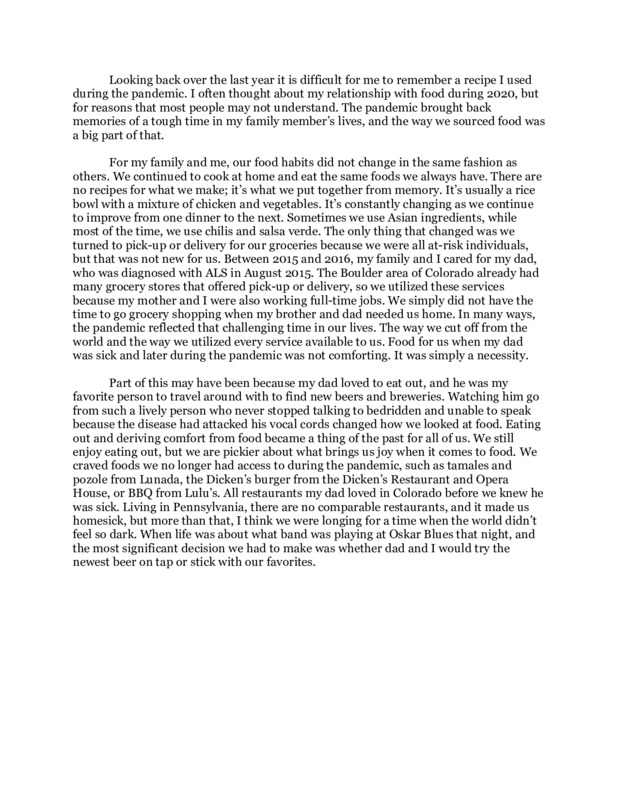
2021-08-07
This is a story of my family's experience with food and the pandemic. For us, it was a reflection of another difficult time in our lives.
-
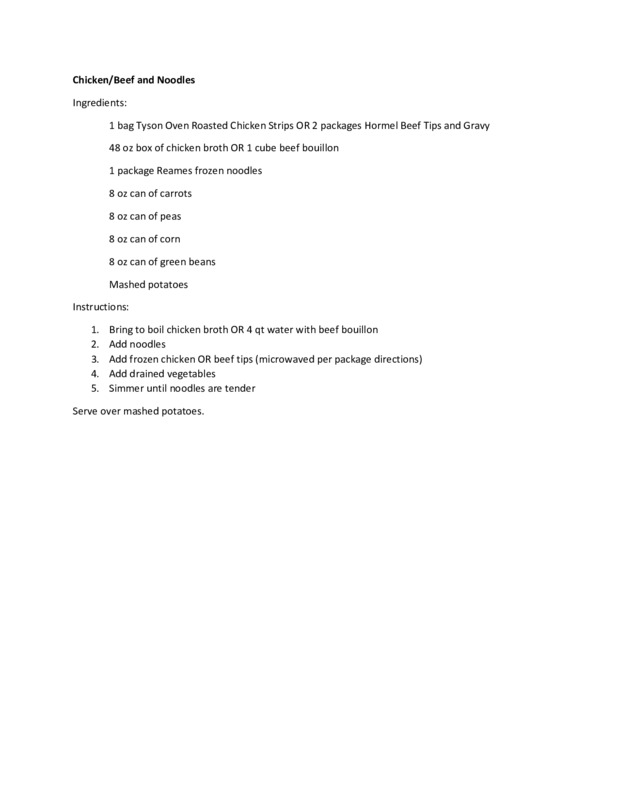
2020-05
While most people tried new recipes during the pandemic, what I remember most is the food shortages that forced me to constantly change what I was planning to make and how I made it. I began using grocery pickup before the pandemic, and since I am a full-time caregiver to my mother who is high-risk for COVID, we continued to use grocery pickup as much as possible to limit any exposure to the virus. Unfortunately, this meant that I could not get halfway through the store, realize that I could not make what I was planning due to unavailable items, and put stuff back and try to buy something else. Though I do have the store substitute most items when they can, especially during lockdown sometimes they couldn’t provide any substitutions, which would leave me without one or two crucial ingredients and unable to fix anything to eat. To combat this, I started getting enough food for two separate dishes for every meal, so if plan A didn’t work out, hopefully plan B would. I also started planning for meals that could be used with the same ingredients, except for one or two, and then get both options just in case one was out of stock. Beef and noodles and chicken and noodles would be one example of this, where the main recipe and ingredients are mostly the same, the only difference being the frozen chicken with chicken broth versus prepackaged beef tips with beef bouillon. Due to their minimal ingredients and their easiness to make, these two interchangeable recipes to me most represent the pandemic and what I fixed the most of during the lockdown and food shortages. I have attached the recipe for both.
-
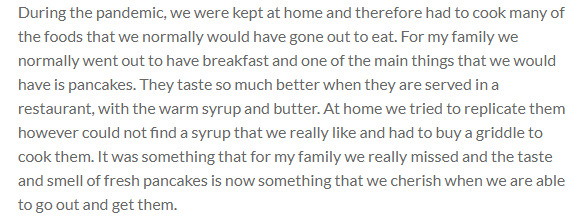
2021-07-02
During the pandemic, we were kept at home and therefore had to cook many of the foods that we normally would have gone out to eat. For my family we normally went out to have breakfast and one of the main things that we would have is pancakes. They taste so much better when they are served in a restaurant, with the warm syrup and butter. At home we tried to replicate them however could not find a syrup that we really like and had to buy a griddle to cook them. It was something that for my family we really missed and the taste and smell of fresh pancakes is now something that we cherish when we are able to go out and get them.
-
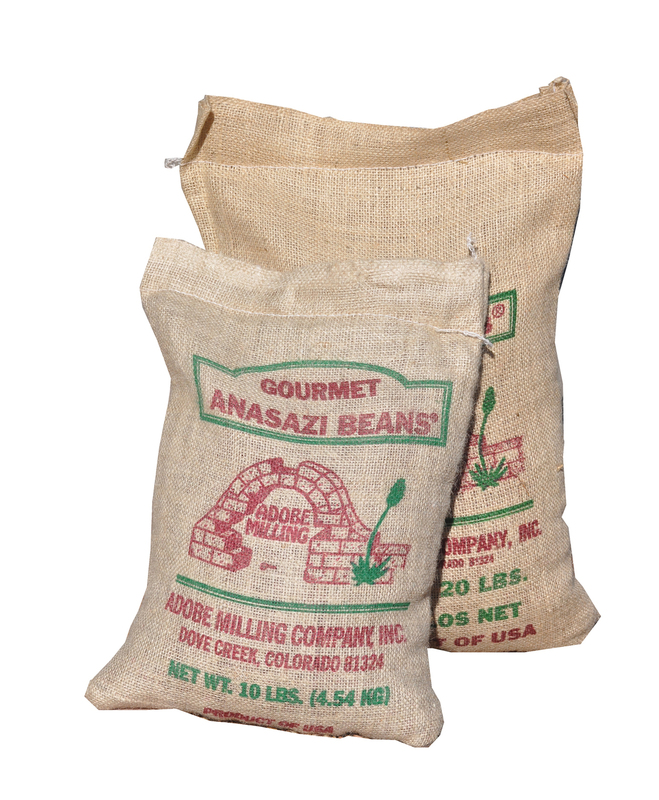
2020-05
In late spring 2020, we begin to realize that it was too dangerous and too expensive to buy fresh produce and meat. The fresh produce was often out of stock for weeks at a time. Then other times the produce just seemed difficult to trust. The grocery store often had people without masks and the COVID numbers were rising. We really couldn't trust any fresh fruits or vegetables unless we cooked them. Eventually as the prices began to rise on fresh meats, we stopped buying those too. Eventually we found that the pandemic had completely altered our day to day eating habits. We didn't always trust restaurants for takeout since they had COVID outbreaks also. Living in a small rural town, we had limited options. This left us trying to buy a few canned foods at stores or ordering delivery of shelf-stable foods in bulk from online retailers.
One of the things that I remember the most is how I began to struggle with my blood pressure. We were eating too many boxed and canned foods; not enough fruit and vegetables. My sodium intake was high and my potassium was low. We then decided we would start buying dehydrated vegetables and fruit. We tried not to buy canned versions that were preserved with salt. The main thing I remember is that one of the first meals that seemed so good and healthy was a meal of Anazazi beans. We had bought some in New Mexico the year before and really liked them. This time we bought a 10 lb bag and assumed that we may have to stock up as the pandemic continued on. We also bough dehydrated onions, dehydrated jalapenos, and other dehydrated mixed vegetables. We did an instant pot of the beans and what ingredients we had. We really enjoyed it. For the first time in weeks, it felt like a real meal. And this was a hot meal during a warm time of year, something we would normally never cook before 2020.
Here is the instant pot recipe and with the ingredients we had, leaving out the ones we didn't have. We adapted as best we could. The original full recipe is linked for comparison.
The recipe we found:
Instant Pot Anasazi Beans
Ingredients
2 cups. dried Anasazi Beans
6 cloves garlic, peeled and smashed
4 c. low sodium chicken stock
1 c. water
1 fresh bay leaf (or 2 dried)
1 t. cumin
1 t. dried oregano
1 t. dehydrated jalapenos
1/8 c. dried onion
salt and pepper to taste
Instructions:
1. Place dried beans, crushed garlic cloves, chicken stock, water, cumin, oregano, bay leaves, dehydrated jalapenos, and dried onion in instant pot.
2. Close lid and pressure cook at high pressure for 25 minutes, then pressure release for roughly 15 minutes. Open the lid carefully.
3. Switch pot to soup setting. Stir occasionally for about 10 minutes. Taste and season with salt and pepper.
4. Serve.
http://eliotseats.com/2019/01/27/instant-pot-anasazi-beans/
-
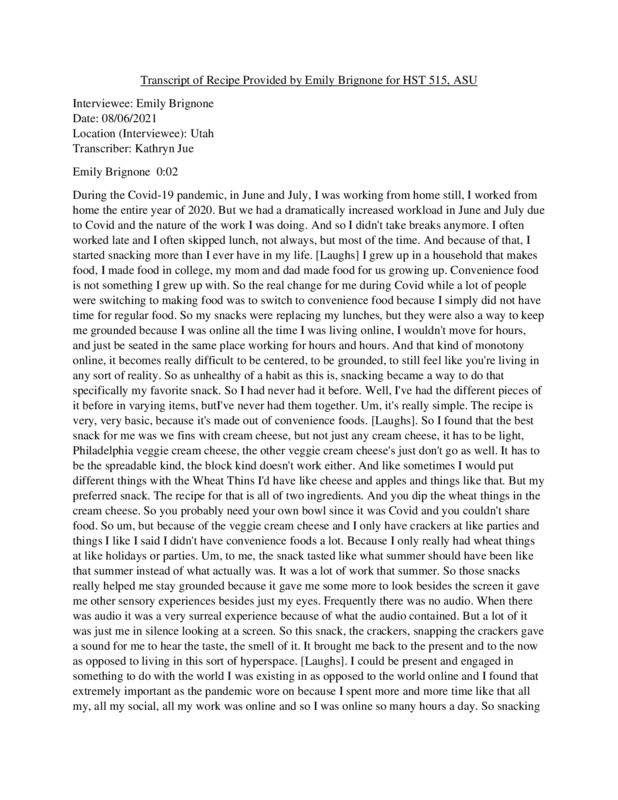
2021-08-06
While working from home I started snacking a lot as I frequently missed breaks and lunches due to the increased workload I also tended to work later than before so while I had no commute I stopped working around the same time I would have gotten home if I had been in the office most of June and July. I found snacking was a way to stay present in the physical world while living almost exclusively online during work hours and frequently replaced or at least supplemented some very hurried lunches. My favorite snack I had never tried before but it was suggested to me by someone who later passed from Covid and so now reminds me not only to be grounded but of them. My favorite snack is really simple but was new to me: wheat thins with light veggie cream cheese. It tasted like what the summer should have been instead of what it was. It was also a shift for me since I didn't eat a lot of convenience foods before COVID I took the time to make food so the idea of creating little snacks to replace generally more nutritious and regulated food was new to me.
-

2021-08-06
The COVID-19 pandemic brought about many difficult changes to people’s daily lives, including self-quarantining. In 2020, I bought a pressure cooker. The pressure cooker is a device that has made cooking for my family easier. When we couldn’t go out to the store, it allowed us to use ingredients we had at home to make easy and hearty meals. Beef stroganoff quickly became a loved recipe in my house, and we would make it whenever we could not go out to the store. It required little effort and always tasted delicious. This was the perfect dish for when we were sick and stuck at home, and we felt rejuvenated after eating it.
-

2020-02-01
While this may be a trivial struggle, the pandemic minutely affected my morning traditions. As someone who wakes up with just enough time to get ready and run through a drive-thru before work, the closure of my go-to Starbucks caused an abrupt halt in my morning routine. I could no longer grab my morning coffee and signature egg bites or great my favorite baristas as I headed off to work. After the swift investment in an Instantpot, I read through numerous recipes in an attempt to get my mornings back to "normal." As I located a sous vide egg bite dupe for those made at Starbucks, I quickly began experimenting with numerous combinations of veggies and meats for my sunrise snack. After several attempts and failures, I eventually mastered the egg bite, and now I consider them a staple of my repertoire. While my mornings were still far from "normal" due to the numerous restrictions set because of the pandemic, a little piece of me felt the comfort that stemmed from the creation of these little egg bites and my coffee in the morning. This experience that spawned out of the events caused by the pandemic forced me to become a better cook and an ingredient-conscious one at that! I've found the kitchen to be a place of comfort and artistic expression now that I know how to appreciate my ingredients, tools, and desire to learn more about cooking!
-

2021-08-02
The COVID-19 Pandemic led me to try a new and challenging recipe of Macaroons. This is my experience.
-
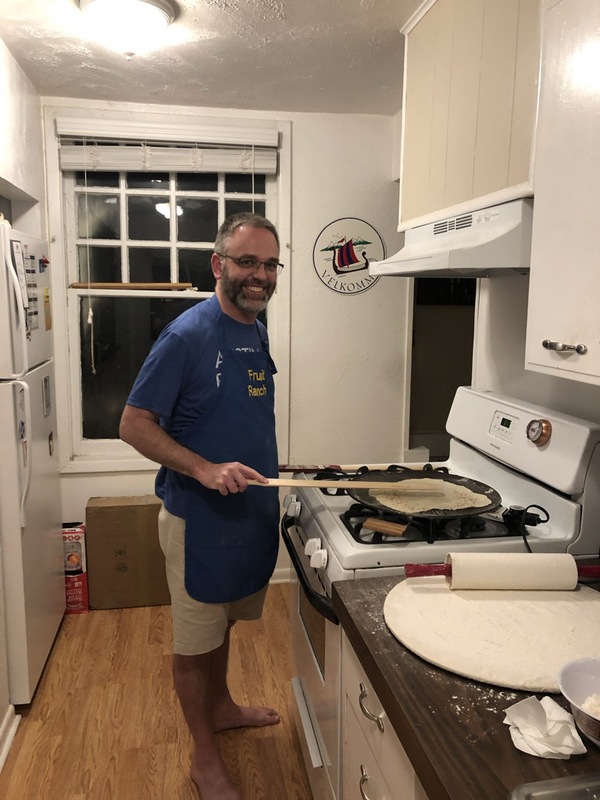
2020-11-30
One of the traditions in my family is to make lefse, a type of Norwegian flatbread, at Christmas time. This tradition was started by my grandmother, because it was one of the foods that she associated with her childhood Christmases as the child of Norwegian and Swedish immigrants. Every year, no matter what was going on, we gathered together as a family at the start of the Christmas season to make lefse.
If you’ve made lefse before, you can attest to it being a labor-intensive process, which involves ricing pounds of potatoes, rolling out dozens of balls of dough until they are paper thin, and frying them one by one on a hot griddle. It’s one of those recipes that works better if you have several people to help. In my family, everyone had a job to do. The youngest children of the family were put in charge of popping air bubbles that rose from the dough while it cooked. The older kids took turns flouring the rolling boards and rolling out the dough. The adults were responsible for cooking the lefse, a process that involved transferring huge rounds of dough to the hot griddle using long turning sticks. Even family members who were not culinarily inclined were put to work, folding the finished lefse and packaging it up so that it could be frozen, so that it was available for Christmas morning. It was a family affair, that filled the kitchen up with laughter and stories and more than one flour fight. Family lefse day is one of the most enduring memories of my childhood.
When the pandemic made it unsafe to travel or even to visit my family, I found myself facing a Christmas without being able to participate in my family’s lefse making tradition. There were many teary video calls to family members as we all came to terms with the fact that we would be missing this tradition for the first time in nearly 40 years. At this point, after enduring months of isolation because of COVID-19, I was devastated. It didn’t feel like the holidays without this tradition and making lefse by myself felt overwhelming. I was telling my friend Mike about how sad I was over missing out on this tradition, when he offered a solution. We would both quarantine for 14 days, purchase all the ingredients we needed and have them delivered, and then he and I would make as much lefse as we could.
I was stunned by his generosity. After all, this was not his tradition. In fact, he’d never even eaten lefse before. But he saw a way that he could help a friend feel better after such a trying year. So, we did just that. With only two of us, it took us about six hours, but we ended up with nearly thirteen pounds of lefse that eventually got sent to family members in four different states. The best moment came when we all video chatted from our homes on Christmas morning, just to eat the lefse together. It was different than normal, but it was a joyous moment. Mike joined us on the call and shared some of the challenges we had making thirteen pounds of lefse in a tiny apartment in the middle of a pandemic. This year, he’s been invited to my parents’ house to join in on the family lefse making day. After all, it’s tradition.
-

2021-08-02
The attached text story is a curry recipe that my wife and I 'perfected' while experimenting with new recipes during COVID-19. With the additional time to cook it was fun to try new things in the kitchen.
-
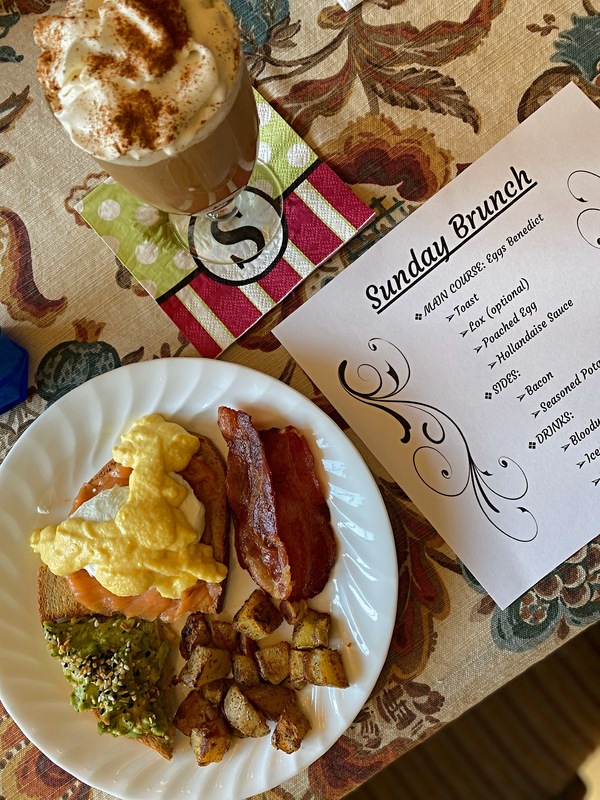
2020-03
Before the pandemic, one of my favorite ways to celebrate a special occasion was by going to brunch in New York City. Understandably, once the pandemic began, I knew that it would be a long, long time before I would see those city lights again. Rather than get down in the dumps, I decided to improvise and bring the brunch experience to my family home as a way to lighten the rather grim mood. A few weeks into the lockdown mandate in March 2020 I told my family to stay away from the kitchen. I organized a brunch with avocado toast, bacon, fried potatoes, and the centerpiece, a meal I had never made on my own, and a brunch staple, eggs benedict. I learned how to poach an egg for the first time with a few failed attempts. I then decorated the plates with the hollondaise sauce as if it were at a 5 star city restaurant. I made menus with drink options ranging from mimosas to bloody Mary’s and served my family, pretending I was out in the city for a celebratory brunch, despite the lack of celebrating going on in the world at the moment. Even if for an hour, this experience eating brunch lightened our moods and reminded us that despite what was going on outside our home, we at least had each other.
-
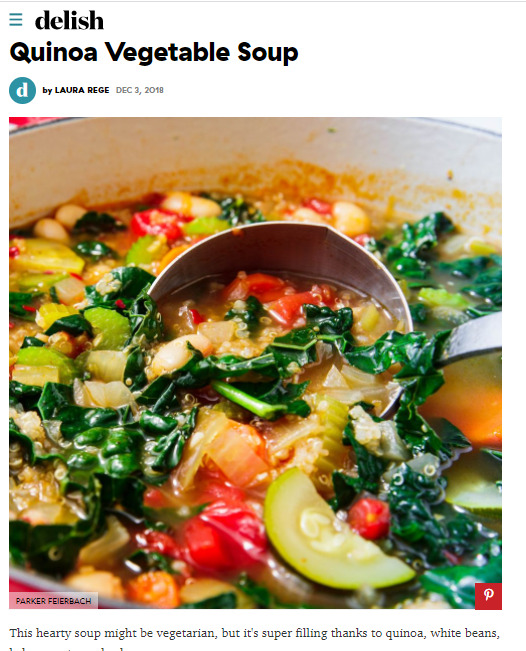
2021-08-02
When the Pandemic first broke out, I was concerned that I would catch the virus since I was working in an elementary school at the time. I thought of various ways to boost my immune system and I thought making healthy soups sounded like the best idea. I looked through the internet and I found this healthy quinoa soup recipe. I tried it and absolutely loved it. It was savory, hearty, and contained a rich blend of rustic flavors. This dish became one of my favorites throughout 2020 and I still cook it from time to time. For anyone looking for a healthy way to fight the virus, I recommend this recipe.
-
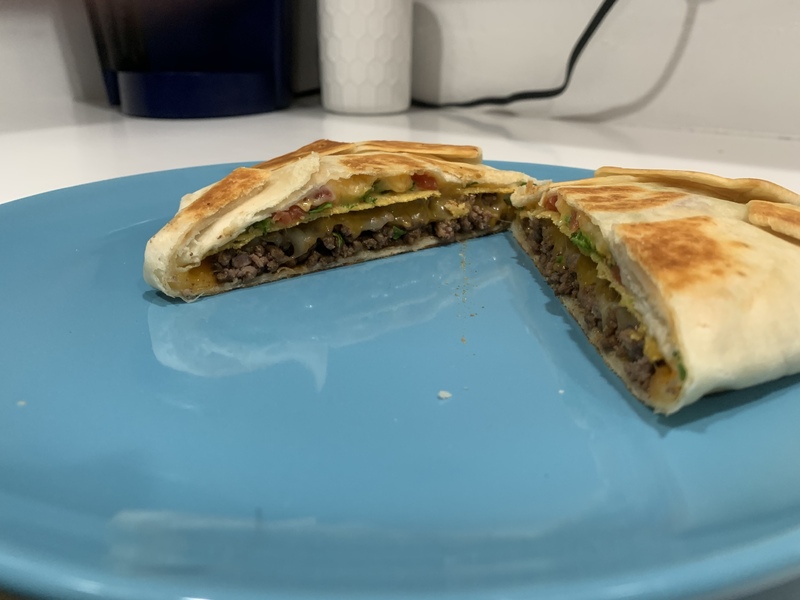
2020-08-17
In the midst of the chaos of: at home learning, quarantine, and the endless stream of commercials asking to support major corporations such Mcdonalds and Taco Bell, the epiphany that fast food could be made...slower, safer, but just as nostalgic, came to mind. No longer will you have to put your life, or an essential workers life, on the line for mediocre fast food!
In order to emulate the staple dish of a CrunchWrap Supreme, the following ingredients are necessary.
Recipe Ingredients:
- 16 oz of Ground Beef
- 4 Large Tortillas
- 8 medium size tortillas
- 1 head of lettuce
- 4 oz of tomatoes
- 2 oz of peppers
- 4 tablespoons of sour cream
- 6 oz of cheese
- 1 tablespoon chili powder
- ¼ teaspoon garlic powder
- ¼ teaspoon crushed red pepper flakes
- ¼ teaspoon dried oregano
- ½ teaspoon paprika
- 1 teaspoon salt
- 1 teaspoon black pepper
Steps to Make It
01
Layer skillet with oil and heat to medium or medium-high heat. Allow the oil to heat before adding the medium tortillas.
Once the oil has begun to "pop" place one tortilla into the pan. It should sizzle immediately, cooking for about 10 to 15 seconds. Repeat until 4 medium tortillas have been cooked.
02
On Medium Heat place the ground beef on the skillet. Add powders, spices, as meat cooks.
03
As the beef is cooking, dice the tomatoes, peppers, and place in a small mixing bowl. *note a food processor may be used as a substitute
04
As the beef has finished cooking, set aside for 5 minutes
05
Assembly:
Place 2-4oz of the cooked beef in the center of an uncooked large tortilla,
06
Apply a spoonful of cheese, and diced peppers and tomatoes, and lettuce
07
Place a medium fried tortilla atop the meat,cheese, and lettuce mixture
08
Spread ½ tablespoon of sour cream, place another spoonful of cheese, diced tomatoes and lettuce
09
Place a medium uncooked tortilla atop the fried medium tortilla
10
Begin to fold the large tortilla’s outer edges over the filling, creating a five sided shape
11
Reheat the skillet to medium heat and place the CrunchWrapSupreme, seam side down, on the hot pan. Cook until lightly golden. Flip and cook on the other side for 1-2 minutes.
12
Repeat steps 5-11
13
Enjoy!
-

2020-08-15
The image I included shows the sense of sound. In the picture submitted my two close friends and I are laughing in a picture together. The story I am regarding with this is the fact the pandemic deprived me of hearing not only their voices in person but also their laughter. In my state we started the lockdown by late March, so all of us were not quarantining together, so the time when the pandemic was the worst was the longest, we went without seeing each other in person. Of course, like other people, we would use technology, like Facetime and Zoom. Like most other people know, Zoom is not the same as in person. So this picture shows us laughing and for the first time in a really long time to hear us all laughing was musical. I think this particular sensory history shows the importance of what a person hears from day to day, or on a regular basis. It becomes clear in times of global pandemics what gets taken for granted until it is taken away. I think when this history gets studied in years to come, historians are going to see a recharge in what people think is important. Those simple things, like a friend's laugh, were lost in the time of quarantine.
-
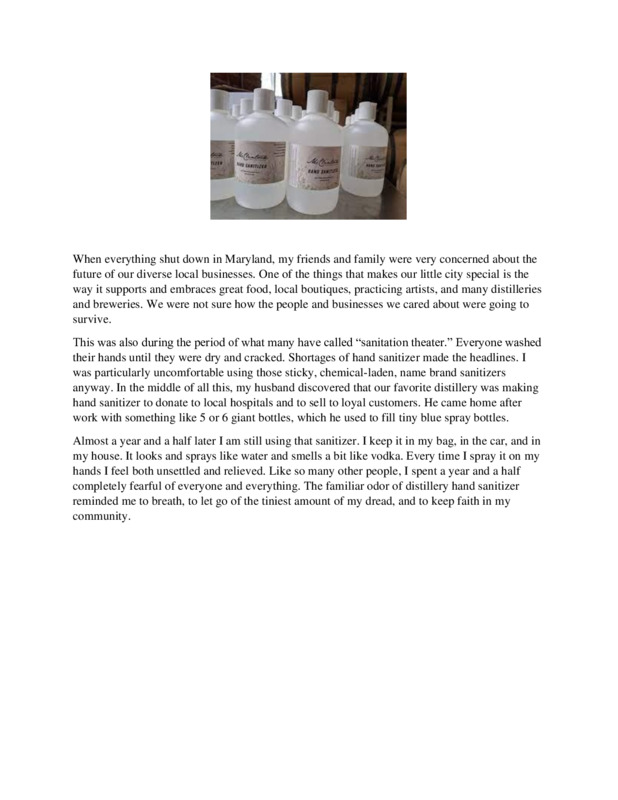
2020-06-14
This is a story about how hand sanitizer kept one woman hopeful during the pandemic. "Sanitation theater" was a coping mechanism used by individuals, businesses, and organizations used to convince ourselves that we were safe. So much of what we needed during the pandemic, was respite from the dread and insecurity. So much was unknown and so much felt out of control. The smell of the hand sanitizer produced by my local distillery instantly evokes the emotions I felt at the height of the pandemic
-

2020-12-04
Overcrowded movie theaters, expensive popcorn, and escapism entertainment made for the best days as a child of the 20th century. Surrounded by an ever growing crisis of climate change, the rising political tensions domestic and foreign; nearly every issue fades away as the lights dim in a theater, directing all attention to the action set pieces of the latest blockbuster hit. Unfortunately now, there are no lights to dim, no popcorn to smell, the once intense reverberating sound and art of audio mixing, is now forced to protrude from broken TV sound bars. The magnificent subtle nuances of orchestral scores, become muffled by the yelling of neighbors. As basic and selfish as it may seem, Covid-19 served as a reminder of the unobtainable nostalgia and senses that surround my past, the art of escapism through film. In 2020 I witnessed the passing of loved ones, relationships dwindle, and ironically the comfort of escapism...has now escaped me. Movie theaters were closed, the discomfort of the slightly course and rough woven stitched seats, became a desperate dream, a return to normalcy. The artificial smell of buttered popcorn, along with the overpriced snacks, became memories of an easier past.
I wrote Henshin, as a manifestation of the changes of Covid-19. It isn't necessarily that films can never be enjoyed again, but the ability to truly escape, is gone. We view, smell, feel and see things differently now. The bombastic sensation within a theater, sharing the laughs, cries and emotions with other children, is now replaced with a constant checking of watches to return again to the world. The smell of artificial flavoring may be gone forever. Loved ones will never carry us out of a theater again. The inconvenient sounds of crowds, machines, and other viewers, are now replaced with conventional house noises. Undoubtedly film will return, theaters will open up again, but the once wholesome experience from the past has changed. The families laughs have now turned to cries, quoting movies with one another has turned to editing eulogies, smells are now memories instead of new experiences.
-
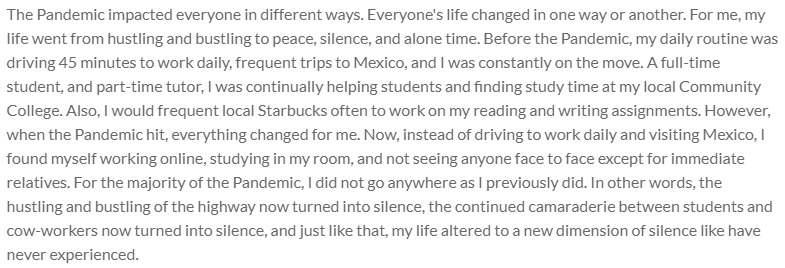
2020-06-26
The Pandemic impacted everyone in different ways. Everyone's life changed in one way or another. For me, my life went from hustling and bustling to peace, silence, and alone time. Before the Pandemic, my daily routine was driving 45 minutes to work daily, frequent trips to Mexico, and I was constantly on the move. A full-time student, and part-time tutor, I was continually helping students and finding study time at my local Community College. Also, I would frequent local Starbucks often to work on my reading and writing assignments. However, when the Pandemic hit, everything changed for me. Now, instead of driving to work daily and visiting Mexico, I found myself working online, studying in my room, and not seeing anyone face to face except for immediate relatives. For the majority of the Pandemic, I did not go anywhere as I previously did. In other words, the hustling and bustling of the highway now turned into silence, the continued camaraderie between students and cow-workers now turned into silence, and just like that, my life altered to a new dimension of silence like have never experienced.
-

2021-05-13
My work ends here on 5/15/2021, I have curated on this website for 2 semesters at ASU and have read sad stories, funny stories, stories that are strange, and people who seem so lost, It was a nice refresher to see how people reacted to pandemic a lot more than my old job which was captioning hard of hearing people's phone calls. I heard so much more death and depressing tales there than in this archive which I find interesting but I have seen many sides of the pandemic. I did have to caption, not once but twice, old people having phone sex from that job and here have read hundred of children ponder the origin of the COVID-19 virus. It is strange but I have seen and lived many lives this pandemic thanks to my jobs.
-
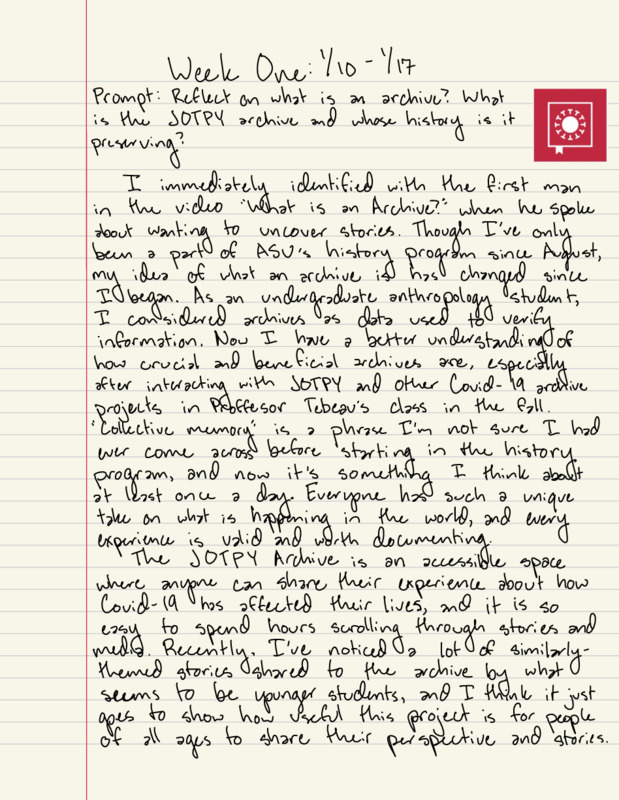
2021-04-25
Going into this internship, I really didn’t know what to expect. Throughout undergrad, I worked full time jobs and did not have the time to take on any internships or research positions, so this was my first experience with it. I also was studying anthropology and was uncertain what path I wanted to take, making it hard to find internships that felt applicable to my future. Once I decided to study history with a goal of pursuing a public history career, this internship seemed like an incredible opportunity to learn more about the field and get a feel for what a possible future career could be. Thanks to the Public History Methodology course taught by Dr. Mark Tebeau, I did have a decent amount of knowledge of what public history consisted of, which made it clearer to me what I wanted to pursue and gave me an understanding on which I could build throughout this internship. Working with JOTPY provided hands-on experience in which I could apply this knowledge and learn the applicable skills necessary to practice public history. These skills included managing metadata, conducting and transcribing oral histories, marketing new collections, prioritizing the safety and privacy of contributors, learning to work with a team remotely, and acknowledging and confronting the silences present in the archive. As I continue to volunteer with JOTPY past the end of my internship, I hope to strengthen these skills, growing more comfortable with curating so that I may carry that with me once I move on from this archive.
Given that this was my first experience like this, much of the work I did was initially out of my comfort zone. The scope of this archive was a bit intimidating, and I did not initially understand how important and impactful JOTPY is and will continue to be, even past the pandemic. As the weeks went on, I grew more comfortable curating, as well as interacting with the team over Slack and Zoom, which I hadn’t utilized very much before this internship. I was also unfamiliar with marketing something like a collection, so having the opportunity to do so pushed me past my comfort zone and taught me how to better write for a public audience in a way that is both succinct and engaging. I learned that I really enjoy this type of work, particularly when it came to creating a collection, as it gave me the opportunity to address a silence and advocate for an underappreciated group of people while pulling from personal experience and situations that I have observed. My goal in life is to help people, and this was a great opportunity to help in a more subtle, behind-the-scenes sort of way. Since I had already hoped to pursue a career in the field of public history, specifically working with museums, this internship did not necessarily change my approach; however, it did strengthen my desire to work in this field, and taught me the necessary skills to feel confident that this is the right path for me.
-
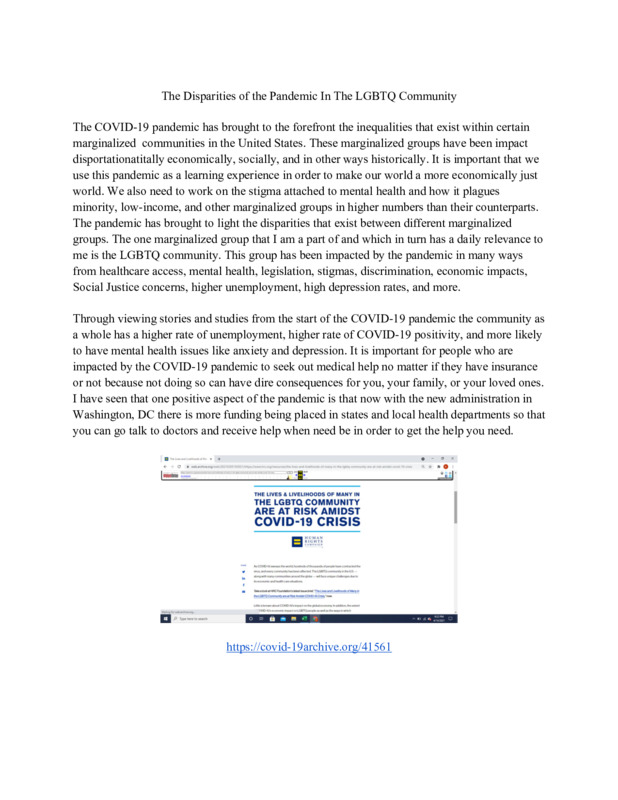
2021-04-25
The internship experience has been one that has taught me many new and different skills that I did not have before or were very low on my abilities prior to this experience. Before I started this internship I had no experience in the field of public history or curation. I gained skills like learning how to preserve various sources for future posterity. I learned the process of properly using a system like Omeka, securing digital sources for the future, working on collections, oral histories, and more. The oral history part of my internship gave me skills that I can bring into my current role as a Social Studies Curriculum Coordinator by having some of our teachers encourage our students to conduct oral histories of our local town members in order to meet their standards in our state. My school uses the hands-on teaching method in order to bring the curriculum alive and this could be one way to implement and bring history alive.
I also sharpened my skills of teamwork, collaboration, and virtual zooming in order to meet a project end goal. One thing this experience has taught me is that the pandemic has caused technology and collaboration to be taken to a next level and that I feel it will continue to grow and change in the future. This experience will also be memorable due to the fact that the actual documentation of the history is occurring while the events are happening not after the fact which is a unique experience.
-
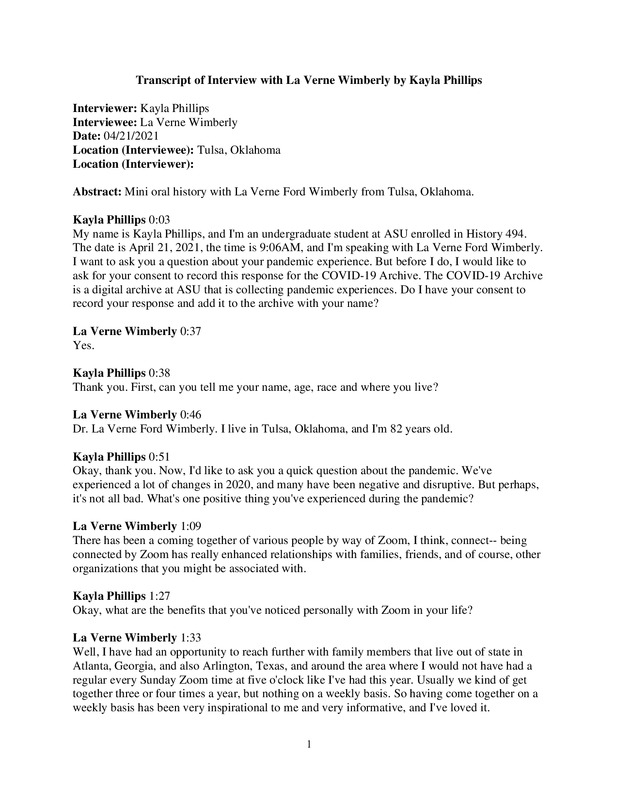
04/21/2021
Mini oral history with La Verne Ford Wimberly from Tulsa, Oklahoma
-
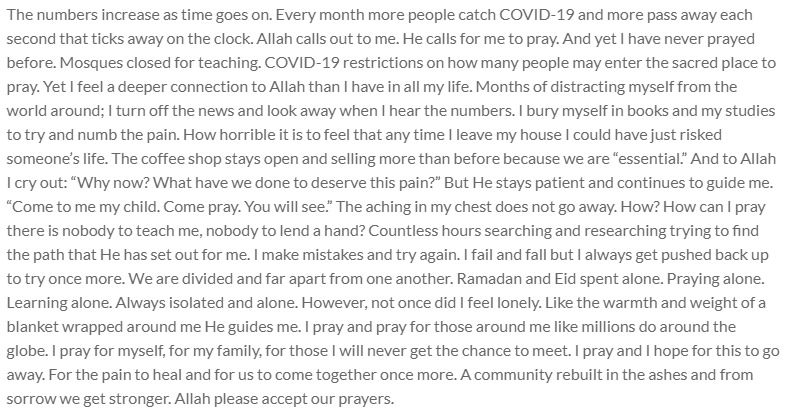
2021-04-23
The numbers increase as time goes on. Every month more people catch COVID-19 and more pass away each second that ticks away on the clock. Allah calls out to me. He calls for me to pray. And yet I have never prayed before. Mosques closed for teaching. COVID-19 restrictions on how many people may enter the sacred place to pray. Yet I feel a deeper connection to Allah than I have in all my life. Months of distracting myself from the world around; I turn off the news and look away when I hear the numbers. I bury myself in books and my studies to try and numb the pain. How horrible it is to feel that any time I leave my house I could have just risked someone’s life. The coffee shop stays open and selling more than before because we are “essential.” And to Allah I cry out: “Why now? What have we done to deserve this pain?” But He stays patient and continues to guide me. “Come to me my child. Come pray. You will see.” The aching in my chest does not go away. How? How can I pray there is nobody to teach me, nobody to lend a hand? Countless hours searching and researching trying to find the path that He has set out for me. I make mistakes and try again. I fail and fall but I always get pushed back up to try once more. We are divided and far apart from one another. Ramadan and Eid spent alone. Praying alone. Learning alone. Always isolated and alone. However, not once did I feel lonely. Like the warmth and weight of a blanket wrapped around me He guides me. I pray and pray for those around me like millions do around the globe. I pray for myself, for my family, for those I will never get the chance to meet. I pray and I hope for this to go away. For the pain to heal and for us to come together once more. A community rebuilt in the ashes and from sorrow we get stronger. Allah please accept our prayers.
-
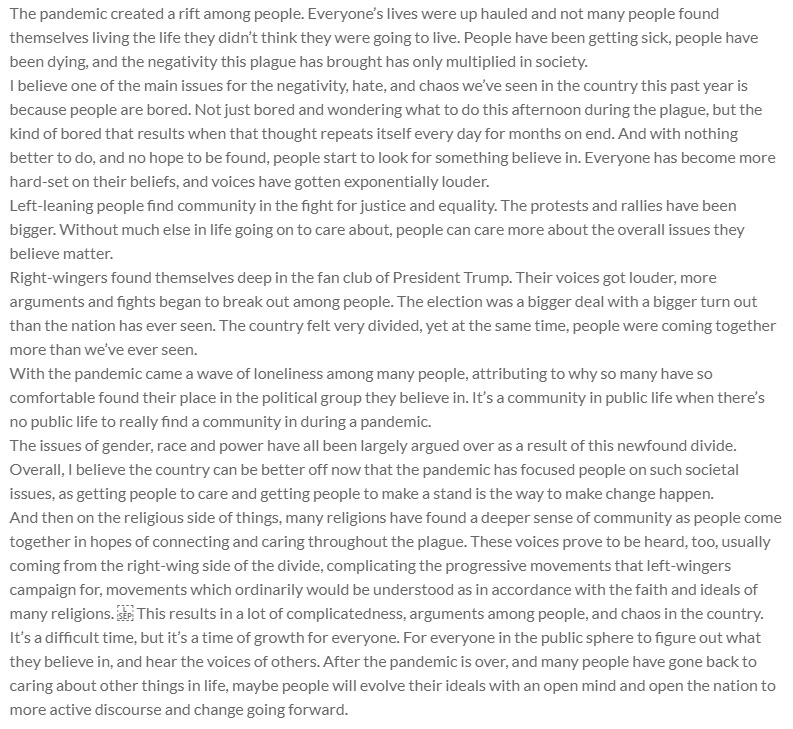
2021-04-23
The pandemic created a rift among people. Everyone’s lives were up hauled and not many people found themselves living the life they didn’t think they were going to live. People have been getting sick, people have been dying, and the negativity this plague has brought has only multiplied in society.
I believe one of the main issues for the negativity, hate, and chaos we’ve seen in the country this past year is because people are bored. Not just bored and wondering what to do this afternoon during the plague, but the kind of bored that results when that thought repeats itself every day for months on end. And with nothing better to do, and no hope to be found, people start to look for something believe in. Everyone has become more hard-set on their beliefs, and voices have gotten exponentially louder.
Left-leaning people find community in the fight for justice and equality. The protests and rallies have been bigger. Without much else in life going on to care about, people can care more about the overall issues they believe matter.
Right-wingers found themselves deep in the fan club of President Trump. Their voices got louder, more arguments and fights began to break out among people. The election was a bigger deal with a bigger turn out than the nation has ever seen. The country felt very divided, yet at the same time, people were coming together more than we’ve ever seen.
With the pandemic came a wave of loneliness among many people, attributing to why so many have so comfortable found their place in the political group they believe in. It’s a community in public life when there’s no public life to really find a community in during a pandemic.
The issues of gender, race and power have all been largely argued over as a result of this newfound divide. Overall, I believe the country can be better off now that the pandemic has focused people on such societal issues, as getting people to care and getting people to make a stand is the way to make change happen.
And then on the religious side of things, many religions have found a deeper sense of community as people come together in hopes of connecting and caring throughout the plague. These voices prove to be heard, too, usually coming from the right-wing side of the divide, complicating the progressive movements that left-wingers campaign for, movements which ordinarily would be understood as in accordance with the faith and ideals of many religions.
This results in a lot of complicatedness, arguments among people, and chaos in the country. It’s a difficult time, but it’s a time of growth for everyone. For everyone in the public sphere to figure out what they believe in, and hear the voices of others. After the pandemic is over, and many people have gone back to caring about other things in life, maybe people will evolve their ideals with an open mind and open the nation to more active discourse and change going forward.
-
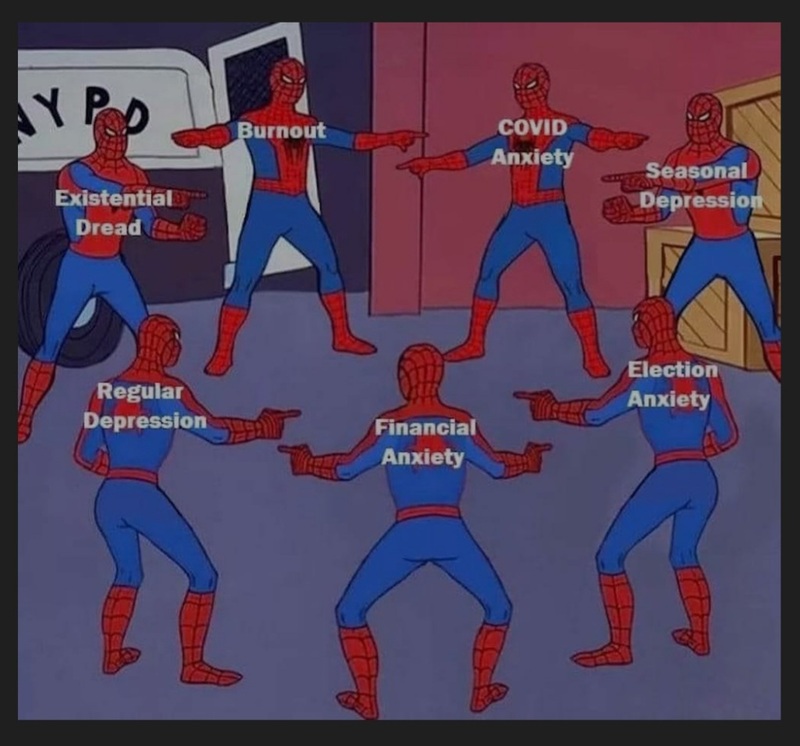
2020-06-08
Although the meme is meant to be comedic, I feel that it reflects the reality of the stressors many people faced during the pandemic. To begin, the anxiety that the coronavirus disease brought into the public severely affected the mental health of many individuals across the globe. During the mandated lockdowns, I , like many others around me, began experiencing a decline in my happy hormones. At the time the pandemic restrictions were being put into place, I was living on campus with three other roommates. With the fear of spreading the disease unintentionally, the three moved out of the dorm right away and I was left to be on my own due to personal housing issues taking place at the time. The lack of interaction with anyone took a toll on my mental health. I missed my friends and my mom, I just wanted to be around someone, but we could only have visitors if they were helping us move out.
On top of personal mental health struggles, events taking place across the country were also scarring. Protests in response to racial injustice under an administration that made it hard to feel safe unless you were a white male in America only added to the helpless state of being. Watching cases upon cases of unjustifiable abuse made the environment only more threatening than it initially seemed when the pandemic was first reported. The election of November 2020 was suspenseful in terms of who would be elected could potentially determine vital living situations for people all across the United States, whether it be immigrant status, being a person of color, or not being able to afford paying for housing in general.
Financial troubles took over the country and the stimulus checks were not enough to cover housing, food, home essentials, especially when some dependents and entire families were not able to receive help because of their citizenship or dependent status. Many tried to turn towards their faith, the keyword being “tried.” Although not all religions focus on gatherings or physical objects, many people were unable to get access to these common preferred forms of practice and felt that virtual gatherings seemed ingenuine or illegitimate.
Overall, the COVID-19 pandemic had many more severe effects on a global scale in all aspects of life. From concerns of the health of others, oneself, finances, practice of faith, and fear of safety in your own home, the negative effects are consistent as it seems that everything continues to pose a threat to daily living. I hope that everything eventually falls back into place and that justice is put in place so that people do not have to fear their own existence.
 2023-02
2023-02 2020-08-08
2020-08-08 2022-08-02
2022-08-02 2022-04-06
2022-04-06 2022-04-05
2022-04-05 2022-04-05
2022-04-05 2022-04-06
2022-04-06 2022-04-06
2022-04-06 2022-04-07
2022-04-07 2022-04-07
2022-04-07 2022-03-07
2022-03-07 2022-03-16
2022-03-16 2022-02-08
2022-02-08 2021-09-22
2021-09-22 2021-09-03
2021-09-03 2021-08-21
2021-08-21 2021-08-08
2021-08-08 2021
2021 2020-03
2020-03 2020-04-14
2020-04-14 2021-08-08
2021-08-08 2020-04-09
2020-04-09 2020-03
2020-03 2020-03-14
2020-03-14 2021-08-07
2021-08-07 2021-03-21
2021-03-21 2021-08-07
2021-08-07 2020-05
2020-05 2021-07-02
2021-07-02 2020-05
2020-05 2021-08-06
2021-08-06 2021-08-06
2021-08-06 2020-02-01
2020-02-01 2021-08-02
2021-08-02 2020-11-30
2020-11-30 2021-08-02
2021-08-02 2020-03
2020-03 2021-08-02
2021-08-02 2020-08-17
2020-08-17 2020-08-15
2020-08-15 2020-06-14
2020-06-14 2020-12-04
2020-12-04 2020-06-26
2020-06-26 2021-05-13
2021-05-13 2021-04-25
2021-04-25 2021-04-25
2021-04-25 04/21/2021
04/21/2021 2021-04-23
2021-04-23 2021-04-23
2021-04-23 2020-06-08
2020-06-08